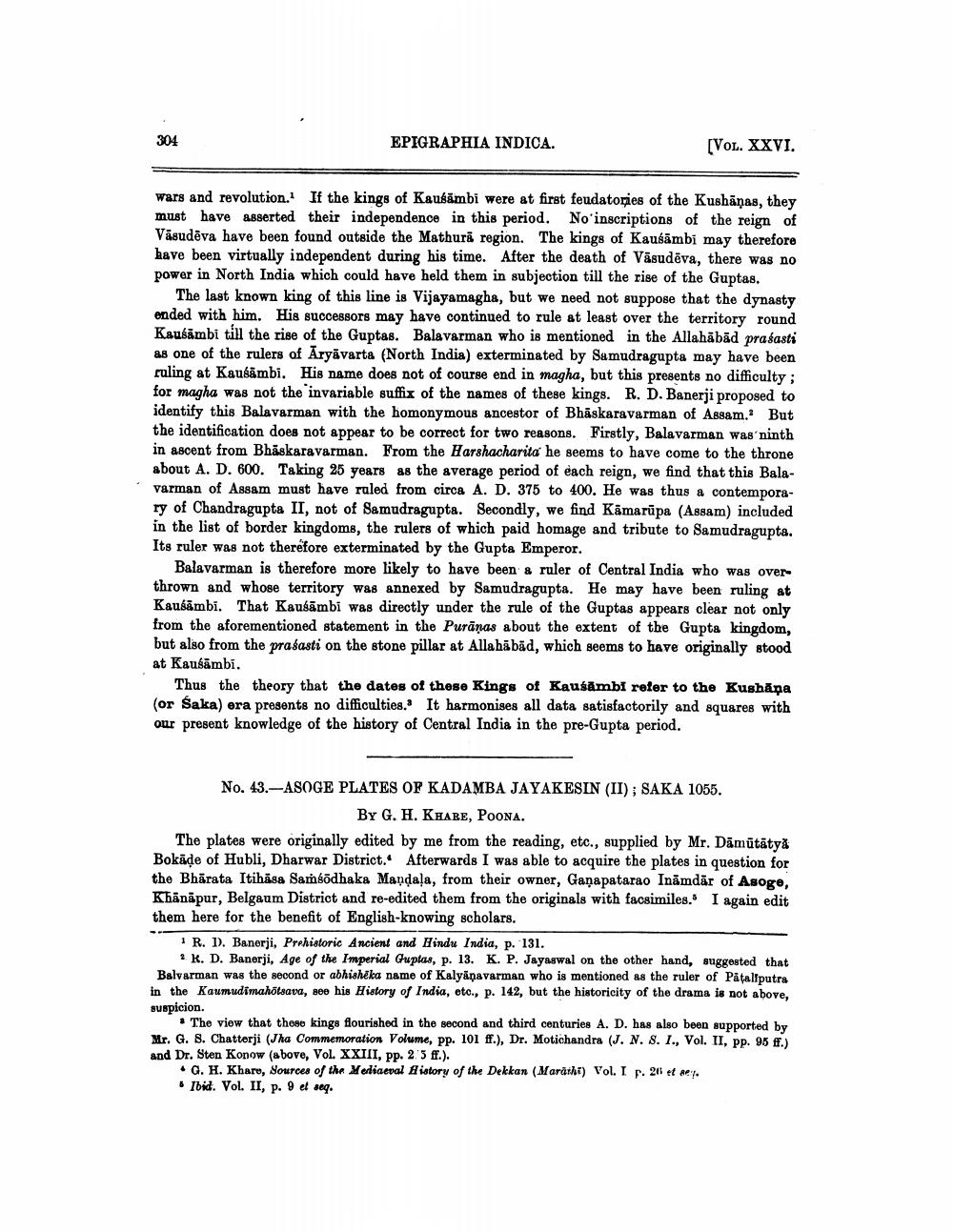________________
EPIGRAPHIA INDICA.
[VOL. XXVI.
wars and revolution. If the kings of Kausāmbi were at first feudatories of the Kushāņas, they must have asserted their independence in this period. No'inscriptions of the reign of Väsudēva have been found outside the Mathurā region. The kings of Kausāmbi may therefore have been virtually independent during his time. After the death of Väsudēva, there was no power in North India which could have held them in subjection till the rise of the Guptas.
The last known king of this line is Vijayamagha, but we need not suppose that the dynasty ended with him. His successors may have continued to rule at least over the territory round Kaušāmbi til the rise of the Guptas. Balavarman who is mentioned in the Allahābād prasasti as one of the rulers of Aryävarta (North India) exterminated by Samudragupta may have been ruling at Kaubambi. His name does not of course end in magha, but this presents no difficulty: for magha was not the invariable suffix of the names of these kings. R. D. Banerji proposed to identify this Balavarman with the homonymous ancestor of Bhaskaravarman of Aggam. But the identification does not appear to be correct for two reasons. Firstly, Balavarman was ninth in ascent from Bhaskaravarman. From the Harshacharita he seems to have come to the throne about A. D. 600. Taking 25 years as the average period of each reign, we find that this BalaVarman of Assam must have ruled from circa A. D. 375 to 400. He was thus a contemporary of Chandragupta II, not of Samudragupta. Secondly, we find Kämarūpa (Assam) included in the list of border kingdoms, the rulers of which paid homage and tribute to Samudragupta. Its ruler was not therefore exterminated by the Gupta Emperor.
Balavarman is therefore more likely to have been & ruler of Central India who was overthrown and whose territory was annexed by Samudragupta. He may have been ruling at Kausāmbi. That Kausāmbi was directly under the rule of the Guptas appears clear not only from the aforementioned statement in the Purānas about the extent of the Gupta kingdom, but also from the prasasti on the stone pillar at Allahābād, which seems to have originally stood at Kausāmbi.
Thus the theory that the dates of these Kings of Kausambi refer to the Kushāna (or Saka) era presents no difficulties. It harmonises all data satisfactorily and squares with our present knowledge of the history of Central India in the pre-Gupta period.
No. 43.-ASOGE PLATES OP KADAMBA JAYAKESIN (II) ; SAKA 1055.
By G. H. KHARE, POONA. The plates were originally edited by me from the reading, etc., supplied by Mr. Dāmūtātyx Bokāde of Hubli, Dharwar District. Afterwards I was able to acquire the plates in question for the Bhārata Itihäsa Samsodhaka Mandaļa, from their owner, Ganapatarao Ināmdär of Asoge, Khānäpur, Belgaum District and re-edited them from the originals with facsimiles. I again edit them here for the benefit of English-knowing scholars.
1 R. 1). Banerji, Prehistoric Ancient and Hindu India, p. 131.
2 K. D. Banerji, Age of the Imperial Guptas, p. 13. K. P. Jayaswal on the other hand, suggested that Balvarman was the second or abhisheka name of Kalyāņavarman who is mentioned as the ruler of Påtaliputra in the Kaumudimahotsava, see his History of India, etc., p. 142, but the historicity of the drama is not above. suspicion.
The view that these kings flourished in the second and third centuries A. D. has also been supported by Mr. G. 8. Chatterji (Jha Commemoration Volume, pp. 101 ff.), Dr. Motichandra (J. N. 8. I., Vol. II, pp. 95 ff.) and Dr. Sten Konow (above, Vol. XXIII, pp. 2.5 ff.).
• G. H. Khare, Sources of the Mediaeval fistory of the Dekkan (Marathi) Vol. I p. 211 et sey. . Ibid. Vol. II, p. 9 el seq.




